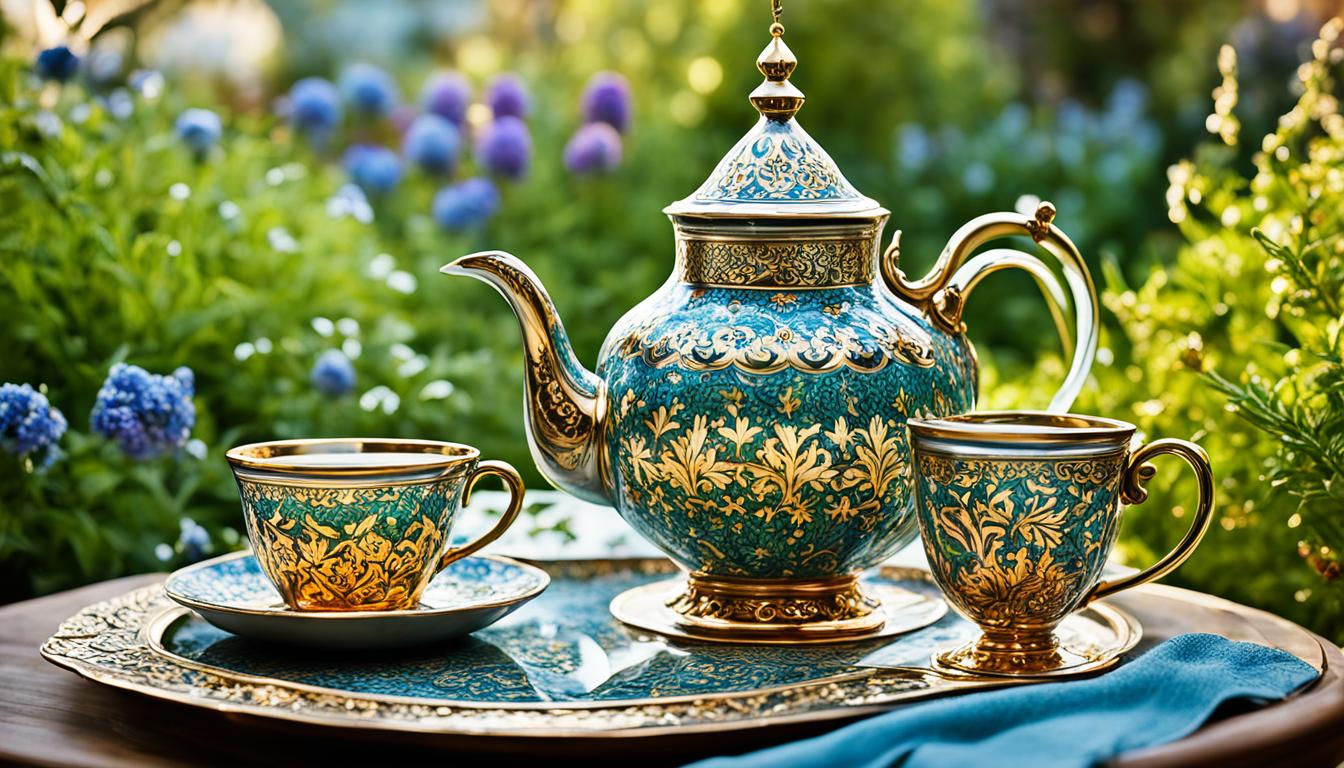Turkey is known for its beautiful scenery and rich culture. Yet, many are surprised to find out it’s one of the top tea-drinking countries in the world. Tea is a big part of life here, from the green Black Sea coast to busy Istanbul. Turkish tea history tells us how tea became a national symbol in just a hundred years. It shows the country’s love for community through tea culture in Turkey.
Drinking this bright red tea, people feel connected to Turkey’s traditions. The Turkish tea rituals invite everyone to learn more about this unique practice. It’s more than just a drink. It’s a way to bring people together and celebrate their culture.
Key Takeaways
- Discover the significance of tea in Turkish social interactions and hospitality traditions.
- Learn about the “seven cups of tea” tradition and its cultural implications within Turkish society.
- Explore the deep-seated historical ties that have influenced the tea culture in Turkey.
- Understand the global scale of Turkey’s tea consumption and its impact on tea-related customs.
- Gain insight into the legends and stories that enrich the world of Turkish tea rituals.
Immersion in Turkish Tea Culture: From Gardens to Cups
The heart of Turkish tea culture is not just in the tea itself. It’s in the act of sharing a cup. This shows hospitality and brings people together. To really get what Turkish black tea means, we look at traditional ceremonies. They build connections across the community.
The Core of Turkish Daily Life and Hospitality
In Turkey, when you give a guest tea, it’s saying “you’re welcome here.” It doesn’t matter who you are or where you come from. This act is woven into everyday life. It shows unity in enjoying a simple cup of black tea.
Tea Heritage in Turkey: Blending Legend with Reality
Turkey’s tea drinking comes with rich tales as tasty as the tea. One legend talks about a wise herbalist who found the secrets of tea. Alongside, there’s the “seven cups of tea” tradition. It reflects life’s emotional journey. These stories and customs show Turkey’s deep tea traditions. They blend age-old wisdom with the real moments of sharing tea.
The Global Position of Turkey in Tea Consumption
Tea in Turkey is much more than a drink; it’s a national passion. Tea consumption in Turkey shows how much the country values this beloved drink. The high amount of tea drunk here places Turkey among the leading tea lovers globally. This love for tea is seen in their tea gardens, family meet-ups, and the common sight of tea trays.
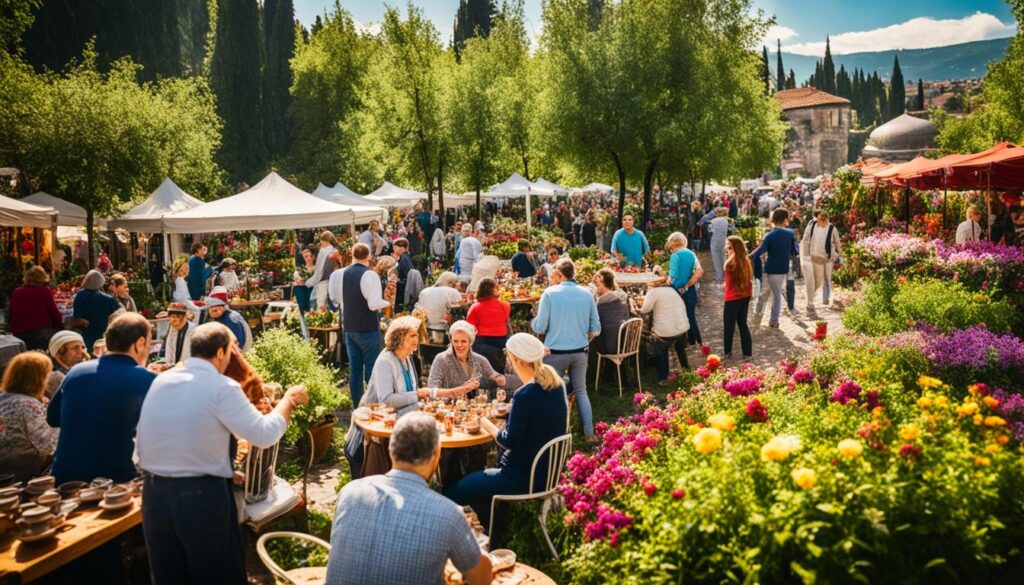
Turkey’s role in the global tea scene is both fascinating and unexpected. Even though tea history in Turkey is quite new, its influence is huge. Everyday, people in Turkey drink more tea than in many other countries with a long tea history. This makes Turkey a blend of modern and traditional in the tea culture in Turkey.
Tea is not a mere drink for Turks; it is an experience that fosters community and reflects the soul of Turkish hospitality.
Looking at tea drinking in Turkey shows us what’s important to Turkish people. It’s more than a habit; it’s a way to connect with family and friends. Tea drinking in Turkey is a sign of their strong ties to tradition and community.
- Tea served as a gesture of welcome in homes and businesses alike.
- The preference for Turkish black tea, brewed to perfection, as a daily staple.
- Celebrations and moments of solace alike are shared over a cup of tea.
Turkey’s relationship with tea shows its deep cultural heritage. The story of their teapots is one of history, toughness, and unity. It’s all about the love of sharing a good cup of tea together.
Historical Journey of Tea in Turkey and Its Eastern Influences
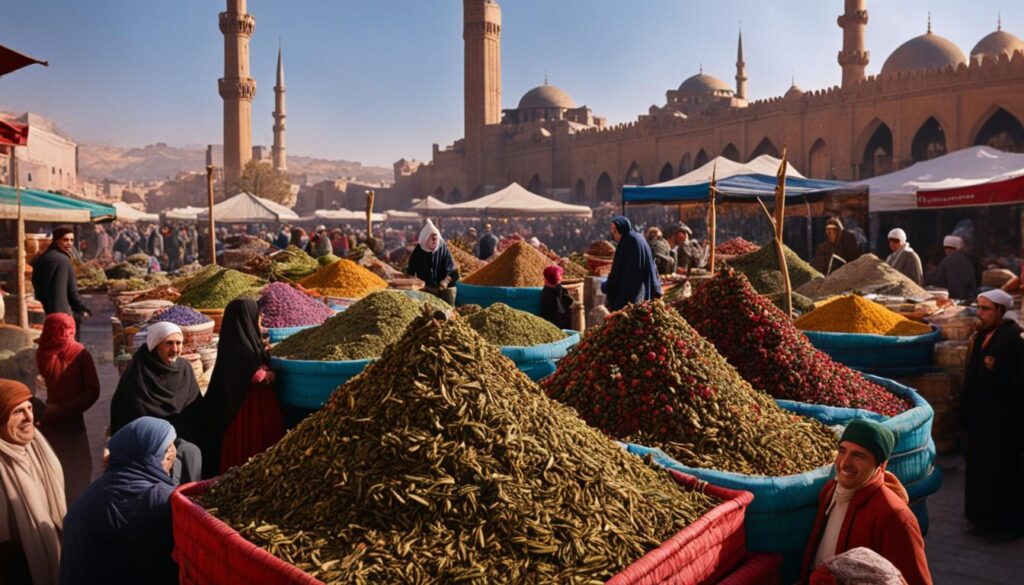
The story of Turkish tea history is both rich and complex. It reflects international ties and diplomacy at key moments. The tea culture in Turkey has roots that reach far beyond its borders. These roots have absorbed diverse cultural influences. As a result, Turkish tea has gone from an imported tradition to a key part of daily life in Turkey.
The Introduction of Tea and Its Early Ambassadors
In the late 19th and early 20th centuries, tea first began to captivate the people of Turkey. Wanderers from across the Asian steppes brought it to them. These wanderers, including diplomats and traders, didn’t just bring tea leaves. They introduced a whole new tradition to Turkey.
Kamil Pasha’s Endeavors and Japan’s Contribution
Kamil Pasha played a crucial role in making tea a staple in Turkey. Fascinated by Japanese tea farming, he initiated tea cultivation in Turkey’s north. Thanks to his vision and Japan’s tea farming methods, tea gardens flourish in the Black Sea area. These gardens are crucial to Turkish tea production today.
| Era | Event | Influence |
|---|---|---|
| Late 1800s | Introduction of Tea by Diplomats | Initial exposure of tea to Turkish society |
| Early 1900s | Kamil Pasha’s Tea Plantation Initiative | Creation of domestic tea production inspired by Japanese practices |
| 1930s | Government Endorsement of Tea | Formal introduction of tea as a national beverage and cultural facet |
In the 1930s, a significant shift from coffee to tea happened in Turkey. Government strategies boosted Turkish tea history. The government helped to embed tea in Turkish culture, making it a symbol of hospitality. Because Turks love socializing, tea became essential in Turkish society. It’s a key part of tea culture in Turkey today.
The Heart of Turkish Tea Production: Black Sea Region’s Bounty
The Black Sea region is lush and rich. It’s where the heart of Turkish tea production beats strong. Tea cultivation here is more than making money. It’s a tradition woven into the area’s culture and farming life. The farms take extra care to keep this tradition of Black Sea tea vibrant. They still pick the leaves by hand. This hard work makes sure the tea is top quality and tastes great.
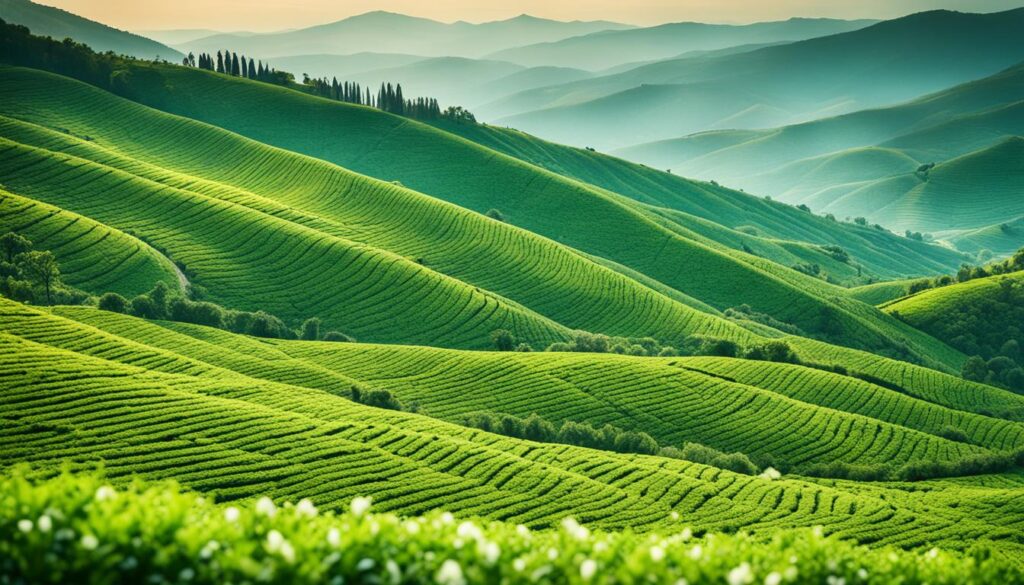
Turkey loves tea more than most countries. Yet, making enough tea for everyone at home is hard. To make up for this, Turkey both imports tea and grows it. Some of the tea grown in Turkey even finds its way to Europe and the U.S. There, people who know a lot about tea love its special taste and high quality.
Key Figures of Turkish Tea Production
| Aspect | Detail |
|---|---|
| Main Cultivation Area | Black Sea Region |
| Harvesting Method | Majority Handpicked |
| Internal Consumption vs. Export | High Local Consumption with Limited Export |
| Export Destinations | Europe and USA |
| Quality Perception | Renowned for Flavor and Quality |
Turkish tea making is an art that tells a story. It’s about keeping old ways while meeting new needs. This tradition continues to flourish in Turkey’s north. It’s a legacy preserved in the green lands of the Black Sea region.
Turkish Tea Culture: Black Tea and Tea Gardens
Dive into the heart of Turkish tea culture. Here, the strong taste of black tea meets the charming vibe of tea gardens. It’s a blend of tradition and chill vibes. In Turkey, making tea and the places for enjoying it are key. They show the real local habits and social life.
Traditional Tea Preparations: The çaydanlık Method
The çaydanlık is at the core of making Turkish tea. It’s a crucial tool that shows the deep culture around black tea. This method is all about skill and age-old knowledge. It focuses on taking your time and being precise to brew the perfect tea. The çaydanlık has two parts. It steeps tea leaves on top while water heats up below. This makes a tea that’s both strong and comforting.
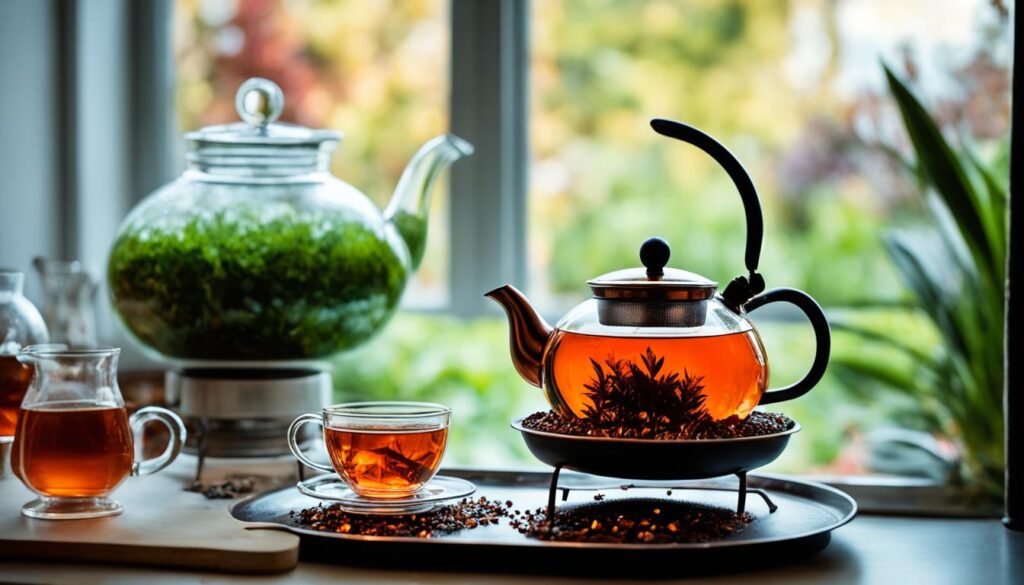
Unpacking the Serenity of Tea Gardens: çay bahçesi
A çay bahçesi offers peace amid city noise. These tea gardens are spots of calm in busy places. They’re where people come together, chat, and relax with aromatic black tea. Tea gardens are more than spots to drink tea. They’re about being together, sharing stories, and taking a break.
| Characteristic | Importance in Culture |
|---|---|
| Ambience of Tea Gardens | A restful backdrop enabling social interaction and cultural exchange. |
| Architecture of çay bahçesi | Designed to blend with the environment, making the tea experience better. |
| Role of Black Tea | It’s key in Turkish welcome rituals and daily living. |
| çaydanlık Brewing | Shows the cultural value of making and drinking tea. |
This honors the long-standing traditions around Turkish black tea. Every part, from the çaydanlık way to the peaceful tea gardens, shows how life can be enjoyed slowly, one sip at a time.
Modern Social Resonance of Turkish Tea Gardens
Turkish tea gardens, or çay bahçesi, thrive as key social spots in busy Turkish cities. They blend traditional and modern aspects perfectly, representing Turkish hospitality and community spirit. These places show the country’s love for coming together and sharing moments.
In these gardens, people from all walks of life meet and share ideas. The çay bahçesi mixes Eastern garden beauty with coffeehouse traditions. It becomes a peaceful break from city chaos, where people can relax and think.
The design of modern tea gardens appeals to everyone. They offer a break from daily life or a spot for deep talks. Here’s a look at what makes these venues special:
| Feature | Description | Significance |
|---|---|---|
| Open Air Seating | Ample seating arrangements set in lush greenery | Encourages gatherings in nature, enhancing the organic Turkish tea experience |
| Traditional Tea Service | Classic çaydanlık tea pots and delicate Turkish tea glasses | Preserves and showcases the customary methods of Turkish tea serving |
| Communal Events | Frequent hosting of cultural events and activities | Promotes shared experiences and the flourishment of Turkish tea culture |
| Variety of Teas | A selection of teas from across Turkey, emphasizing regional varieties | Offers a taste of the country’s rich tea diversity, pleasing avid connoisseurs and curious visitors alike |
Turkish tea gardens play a big role in public social life. They tie traditional tea customs to modern community needs. These gardens are a historic yet ever-evolving part of Turkish tea culture, loved by many.
Conclusion
Turkish tea culture weaves together tradition, legend, and hospitality. It’s like an elaborate embroidery, each thread a vital part of Turkey’s social scene. This tapestry keeps evolving, showing how Turkish people embrace their identity and sense of togetherness. When they share tea, it’s more than a drink. It’s a sharing of Turkey’s communal values with friends, family, and even those they don’t know yet.
The heart of this culture beats with black tea, a symbol of pride. Tea gardens offer a green haven amidst the hustle of daily life. These spots aren’t just for taking a break. They connect the past with the present. They celebrate values important to the Turkish people. Tea gardens are where everyone enjoys the little joys in life, and every sip is a tribute to Turkey’s heritage.
Thinking about tea consumption in Turkey, one sees its magic. It’s a simple drink that brings people together across time. It tells stories of the past and hopes for the future. Enjoying Turkish tea means joining a communal celebration. It’s more than tasting a beverage. It’s feeling the heartbeat of a country that finds deep happiness in the tradition of tea. Turkish tea culture is a harmony of life, community, and heritage, echoing in society.

